Development of an Integrated Water Resource Scheduling Model Based on Platform Plug-In: A Case Study of the Wudu Diversion and Irrigation Area, China
Abstract
1. Introduction
2. Study Area and Implementation of Model Plug-In
2.1. Overview of Wudu Diversion and Irrigation Area
2.1.1. Physical Geography
2.1.2. Irrigation Business Objects
2.2. Overall Design of Integrated Water Resource Scheduling Model Development in the Irrigation Area
2.2.1. Development and Design of Model Function
2.2.2. Phased Model Development Route
- (1)
- Stage 1: Basic scheduling function.
- (2)
- Stage 2: Precise scheduling.
- (3)
- Stage 3: Improvement of forecasting scheduling function.
- (4)
- Stage 4: Improvement and optimization of model function.
2.3. Implementation of Core Model Plug-In in Irrigation Area
2.3.1. Partitioning of Model Plug-In
- (1)
- Conversion function between water level and reservoir capacity: The reservoir capacity to query the associated water level and the reservoir capacity to query the corresponding water level can be entered.
- (2)
- Conversion function between surface and bottom orifice opening and flow rate: Under certain water level conditions, the flow rate and opening of the surface and bottom orifice can be converted from one to the other.
- (3)
- Calculating the function of the reservoir outflow discharge: Average discharge is determined by combining the forecasted upstream inflow with the current water level and opening under the condition of regulated water level at the end of the specified period.
- (4)
- Function of gate opening scheme: The average flow rate of the time is converted into the gate opening scheme of the surface and bottom orifice according to the specified opening and closing rules, which consider planned water consumption of the power station, the current water level, and the discharge dispatching rules.
- (5)
- Function of flood regulating calculation: The process of water level, reservoir capacity, and outflow discharge can be calculated in conjunction with the incoming water forecast and current water level under the specified gate opening scheme. Time periods that do not meet the requirements of the restricted water level or outflow discharge can be screened by specifying the restricted water level or outflow discharge.
- (6)
- Judgment function of downstream safety discharge restraint: The downstream safety discharge is determined by combining the forecasted downstream inflow and determining whether or not the constraint is fulfilled under the stated pre-discharge flow condition.
- (7)
- Other functions: At a later stage, more functional models can be created following standard interfaces as needed to increase the number of application scenarios and the level of automated scheduling.
- (1)
- Function of gate discharge calculation model: The appropriate discharge flow is calculated under the assumption of the stated gate opening combined with the current gate opening, head before and after the gate, gate size, and gate floor elevation.
- (2)
- Function of gate opening calculation: Under the premise of the given discharge, the applicable gate opening scheme is computed using the current gate opening, head before and after the gate, gate size, and floor elevation.
- (3)
- Function of water intake scheme for canal headwork sluice: There is only one sluice gate at the canal headwork section of the intake complex; therefore, the water intake scheme can be directly generated by the gate opening calculation.
- (4)
- Function of water intake scheme for Fujiang sluice: The anticipated discharge of the Fujiang sluice section should be evaluated, and the corresponding gate opening strategy should be estimated while taking ecological, sand scouring, and flood control dispatching laws into consideration.
2.3.2. Creation and Encapsulation of Model Plug-In
- (1)
- Developing languages and tools
- (2)
- Plug-in implementation
- (3)
- Encapsulation of plug-in interface
3. Results and Discussion
3.1. Verification of Model Plug-In
3.1.1. Model Plug-In of Reservoir Outflow Discharge Calculation
- (1)
- Condition setting
- (2)
- Simulation results
3.1.2. Model Plug-In for Gate Opening Scheme
- (1)
- Condition setting
- (2)
- Simulation results
3.1.3. Plug-In Model of Reservoir Flood Regulating Calculation
- (1)
- Condition setting
- (2)
- Simulation results
3.2. Discussion
4. Conclusions
Author Contributions
Funding
Data Availability Statement
Acknowledgments
Conflicts of Interest
References
- Boes, R.M.; Hager, W.H. Hydraulic design of stepped spillways. J. Hydrol. Eng. 2003, 129, 671–679. [Google Scholar] [CrossRef]
- Fouial, A.; Lamaddalena, N.; Rodríguez Díaz, J.A. Generating Hydrants’ Configurations for Efficient Analysis and Management of Pressurized Irrigation Distribution Systems. Water 2020, 12, 204. [Google Scholar] [CrossRef]
- Martino, B.; Mauro, B.; Massimo, D.; Carlo, G. Model-based approach for design and performance evaluation of works controlling stony debris flows with an application to a case study at Rovina di Cancia (Venetian Dolomites, Northeast Italy). Sci. Total Environ. 2019, 688, 1373–1388. [Google Scholar]
- Cancela, J.J.; González, X.P.; Vilanova, M.; Mirás-Avalos, J.M. Water Management Using Drones and Satellites in Agriculture. Water 2019, 11, 874. [Google Scholar] [CrossRef]
- Marta-Almeida, M.; Mendes, R.; Amorim, F.N.; Cirano, M.; Dias, J.M. Fundão Dam collapse: Oceanic dispersion of River Doce after the greatest Brazilian environmental accident. Mar. Pollut. Bull. 2016, 112, 359–364. [Google Scholar] [CrossRef] [PubMed]
- Giannakis, E.; Bruggeman, A.; Djuma, H.; Kozyra, J.; Hammer, J. Water pricing and irrigation across Europe: Opportunities and constraints for adopting irrigation scheduling decision support systems. Water Sci. Technol. Water Supply 2016, 16, 245–252. [Google Scholar] [CrossRef]
- López, I.; Pereiras, B.; Castro, F.; Iglesias, G. Optimisation of turbine-induced damping for an OWC wave energy converter using a RANS-VOF numerical model. Appl. Energy 2014, 127, 105–114. [Google Scholar] [CrossRef]
- Broquetas, M.; Bryde, D.; Volm, J. The project benefits of Building Information Modelling (BIM). Int. J. Proj. Manag. 2013, 31, 971–980. [Google Scholar]
- Vashahi, F.; Dafsari, R.A.; Rezaei, S.; Lee, J.K.; Baek, B.J. Assessment of steady VOF RANS turbulence models in rendering the internal flow structure of pressure swirl nozzles. Fluid Dyn. Res. 2019, 51, 045506. [Google Scholar] [CrossRef]
- O’Connor, J.E.; Duda, J.J.; Grant, G.E. 1000 dams down and counting. Science 2015, 348, 496–497. [Google Scholar] [CrossRef]
- Muñoz, J.G.; Montalban, F.; Gras, J.; Rubi, P.G.; Matador, F. Environmental integrated rules in dams with water quality problems: The Santomera Dam, an example on how to integrate water quality and water quantity needs. In Dams and Reservoirs, Societies and Environment in the 21st Century; Taylor & Francis Group: London, UK, 2006; pp. 237–244. [Google Scholar]
- Shao, H.Z. Application of Plug-in Technology in Computer Software Technology. Inf. Comput. (Theor. Ed.) 2019, 15, 9–10. (In Chinese) [Google Scholar]
- Ren, X.X.; Yu, M.L.; Chen, F.M.; Ma, W.F.; Tang, X.D.; Zhang, S.Z. Integration of Remote Sensing Detection and Evaluation Model for Mineral Resources and Energy Based on Plug-in Technology. J. Cap. Norm. Univ. (Nat. Sci. Ed.) 2017, 38, 70–74. (In Chinese) [Google Scholar]
- Campbell, S.G.; Hanna, R.B.; Flug, M.; Scott, J. Modeling Klamath River system operations for quantity and quality. J. Water Resour. Plan. Manag. 2001, 127, 284–294. [Google Scholar] [CrossRef]
- Kojima, T.; Shinoda, S.; Mahboob, M.G.; Ohashi, K. Study on Improvement of Real-Time Flood Forecasting with Rainfall Interception Model. Adv. River Eng. 2012, 18, 435–440. [Google Scholar]
- Liu, R.F.; Li, Z.S.; Xin, X.K.; Liu, D.F.; Zhang, J.L.; Yang, Z.J. Water balance computation and water quality improvement evaluation for Yanghe Basin in a semiarid area of North China using coupled MIKE SHE/MIKE 11 modeling. Water Supply 2022, 22, 1062–1074. (In Chinese) [Google Scholar] [CrossRef]
- Palaka, R.; Sri Charnan Reddy, P.; Viharika, G.; Pravalika, G. Design of Urban Storm Water Drainage System using GIS and SWMM Software. In IOP Conference Series: Materials Science and Engineering; IOP Publishing: Bristol, UK, 2021; Volume 1197. [Google Scholar]
- Habibu, I.; Md Rowshon, K.; Md Abdul, M.; Ahmad Fikri Bin, A.; Lai, S.H. Loss methods in HEC-HMS model for streamflow projection under climate change: A review. Int. J. Hydrol. Sci. Technol. 2022, 13, 23–42. [Google Scholar]
- Liu, X.Z. Development and Implementation of Enterprise SIMS Based on B/S Model. In Journal of Physics: Conference Series; IOP Publishing: Bristol, UK, 2021; Volume 2037. (In Chinese) [Google Scholar]
- Francis, R.; Bekera, B. A metric and frameworks for resilience analysis of engineered and infrastructure systems. Reliab. Eng. Syst. Saf. 2014, 121, 90–103. [Google Scholar] [CrossRef]
- Hornbuckle, J.W.; Car, N.J.; Christen, E.W.; Stein, T.-M.; Williamson, B. IrriSatSMS: Irrigation Water Management by Satellite and SMS-A Utilisation Framework; CRC for Irrigation Futures and CSIRO: Sydney, Australia, 2009. [Google Scholar]
- Nakic, D.; Djurin, B.; Hunt, J.; Dadar, S. A Novel Procedure for Minimizing the Volume of Water Tanks in Water Supply Systems. Water 2022, 14, 1731. [Google Scholar] [CrossRef]
- Nugroho, A.R.; Tamagawa, I.; Harada, M. Spatiotemporal Analysis on the Teleconnection of ENSO and IOD to the Stream Flow Regimes in Java, Indonesia. Water 2022, 14, 168. [Google Scholar] [CrossRef]
- Hartini, S. Modeling of Flood Risk of Agriculture land Area in Part of North Coast of Central Java; Universitas Gadjah Mada: Yogyakarta, Indonesia, 2015. [Google Scholar]
- Willemsen, P.; Van der Lelij, A.C.; Wesenbeeck, B. Van Risk Assessment North Coast Java; Wetlands International: Wageningen, The Netherlands, 2019. [Google Scholar]
- Nicholas, J.M.; Kazi, Z. Vulnerability Scanning with Google Cloud Platform. In Proceedings of the International Conference on Computational Science and Computational Intelligence, Las Vegas, NV, USA, 5–7 December 2019. [Google Scholar]
- Peng, P.; Zhang, J.; Wang, J.G. Model Construction of Basin Water Resources Dispatching and Management System. Eco-Economy 2014, 30, 139–142. (In Chinese) [Google Scholar]
- Xiao, Q.P.; Jiang, W.Z.; Tang, J.Z. Application Research on Integrated Automation Information Management System of Water Conservancy Project. China Constr. 2017, 06, 86–87. (In Chinese) [Google Scholar]
- Li, H.L. Customization and Development of Decision Support System for Water Resources Allocation in Liaoning Province. Water Resour. Dev. Res. 2019, 19, 43–47. (In Chinese) [Google Scholar]
- Lei, X.H.; Cai, S.Y.; Wang, H.; Meng, X.Y. Discussion on Key Technologies and General Software Platform of River Water Resources Dispatching. Yangtze River 2017, 48, 37–45. (In Chinese) [Google Scholar]
- Gan, Z.G.; He, X.H.; Cai, S.Y. Application of General Software for Water Resource Dispatching in Manas River. China Water Resour. 2018, 21, 60–62. (In Chinese) [Google Scholar]
- Atlam, H.F.; Walters, R.J.; Wills, G.B. Fog Computing and the Internet of Things: A Review. Big Data Cogn. Comput. 2018, 2, 10. [Google Scholar] [CrossRef]
- Atlam, H.F.; Azad, M.A.; Alzahrani, A.G.; Wills, G. A Review of Blockchain in Internet of Things and AI. Big Data Cogn. Comput. 2020, 4, 28. [Google Scholar] [CrossRef]
- Ma, Z.H. Research and Application of Integrated Water Information System. Ph.D. Thesis, Xi’an University of Technology, Xi’an, China, 2009. (In Chinese). [Google Scholar]
- Shi, F.R.; Wu, H.T.; Kang, C.F. Generation Platform of Water Conservancy Simulation and Calculation System Based on Cloud Service. Comput. Appl. Softw. 2016, 33, 15–19. (In Chinese) [Google Scholar]
- Zhang, G.; Xie, J.C.; Luo, J.G. Plug-in and Application of Flood Forecast Model. J. Hydraul. Eng. 2011, 42, 1479–1486. (In Chinese) [Google Scholar]
- Shil, A.B.; Ahmed, M.B. Additional Functionalities to SOAP, WSDL and UDDI for a Better Web Services’ Administration. In Proceedings of the 2006 2nd International Conference on Information & Communication Technologies, Damascus, Syria, 24–28 April 2006; Volume 1, pp. 572–577. [Google Scholar]
- Gu, Q.F. Plug-in Technology in Computer Software. Comput. Prod. Circ. 2019, 7, 21. (In Chinese) [Google Scholar]
- Sulis, A.; Sechi, G.M. Comparison of generic simulation models for water resource systems. Environ. Model. Softw. 2013, 40, 214–225. [Google Scholar] [CrossRef]
- Ge, J.G.; Liu, H.H. Development of Multi-Software Model Conversion Program Based on PYTHON. Ind. Constr. 2014, 44, 324–326. (In Chinese) [Google Scholar]
- Shi, B.K.; Li, X.; Wang, S.X.; Fan, X.H.; Zhan, Z.Z. Python Web Development Based on Flask. Digit. Space 2020, 3, 43–44. (In Chinese) [Google Scholar]
- Minow, B.; de Witt, H.; Knabben, I. Fast Track API Manufacturing from Shake Flask to Production Scale Using a 1000-L Single-Use Facility. Chem. Ing. Tech. 2012, 85, 87–94. [Google Scholar] [CrossRef]
- Gevorkyan, M.N.; Demidova, A.V.; Korolkova, A.V.; Kulyabov, D.S. Issues in the Software Implementation of Stochastic Numerical Runge-Kutta. In Proceedings of the 21st International Conference on Distributed and Computer and Communication Networks (DCCN), Moscow, Russia, 17–21 September 2018. [Google Scholar]
- Wardlaw, R.; Sharif, M. Evaluation of genetic algorithm for optimal reservoir system operation. J. Water Resour. Plan. Manag. 1999, 125, 25–33. [Google Scholar] [CrossRef]
- Oliveira, R.; Loucks, D.P. Operation Rules for Multireservoir System. Water Resour. Res. 1997, 33, 839–852. [Google Scholar] [CrossRef]

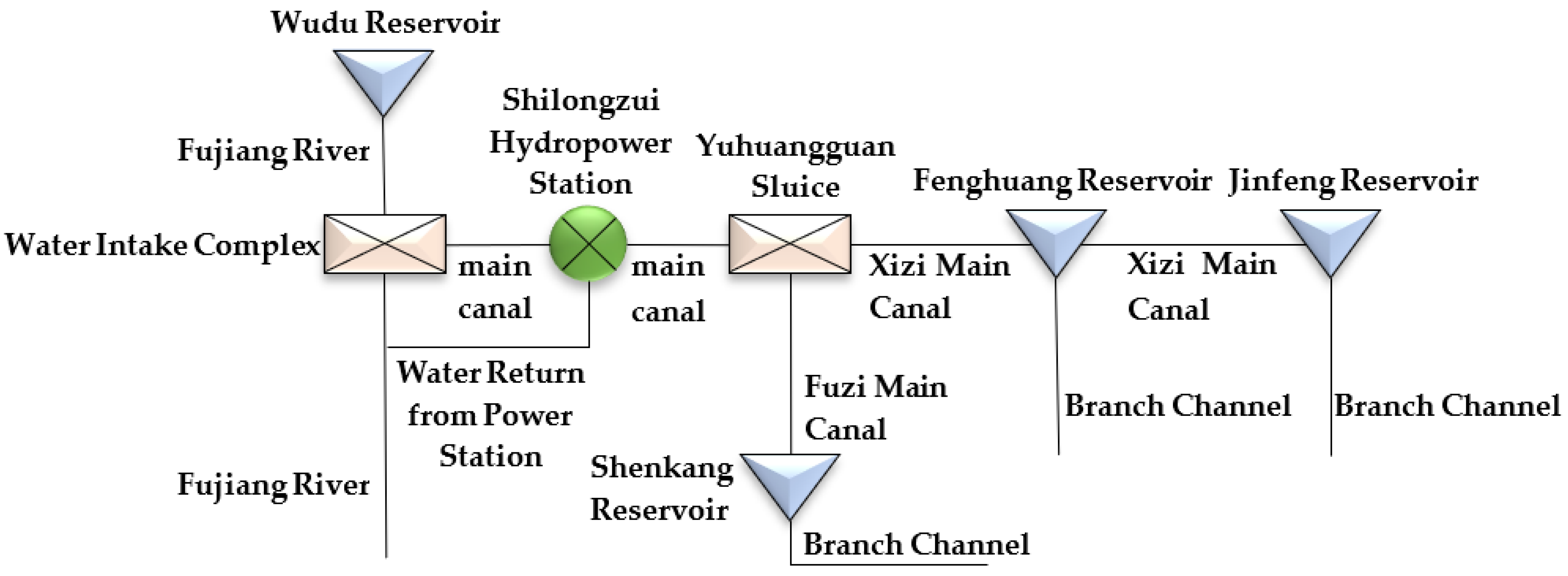
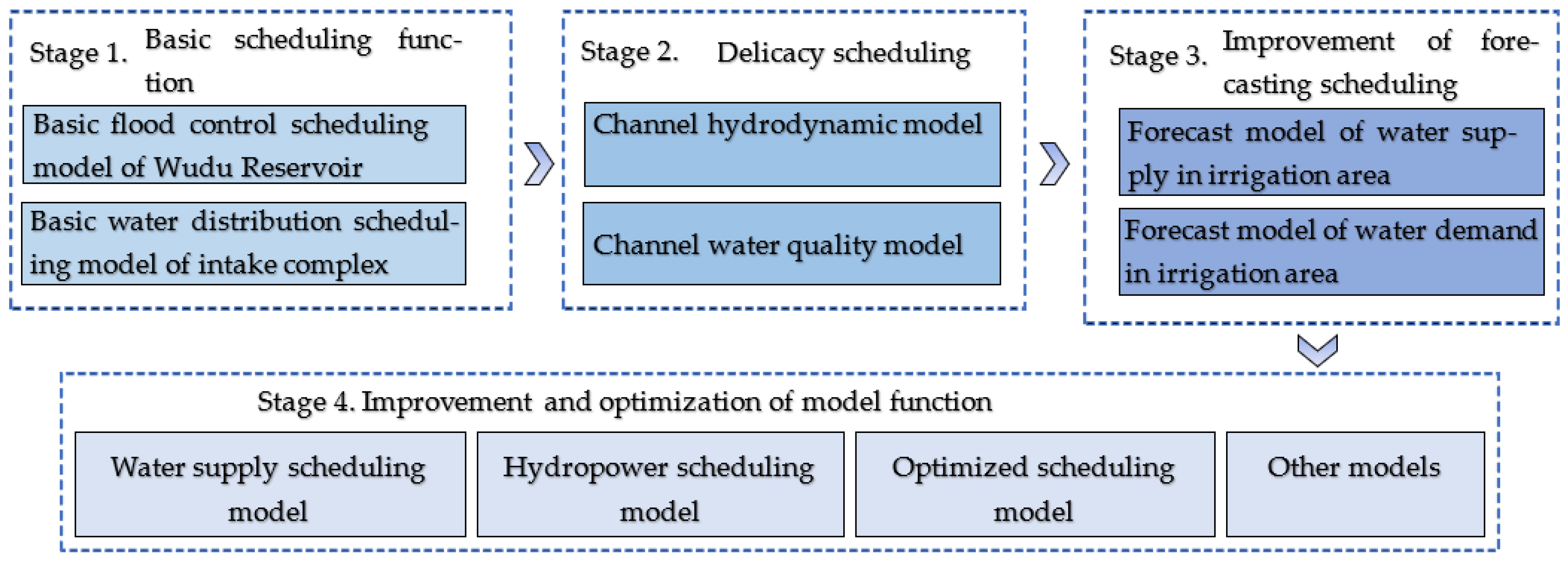
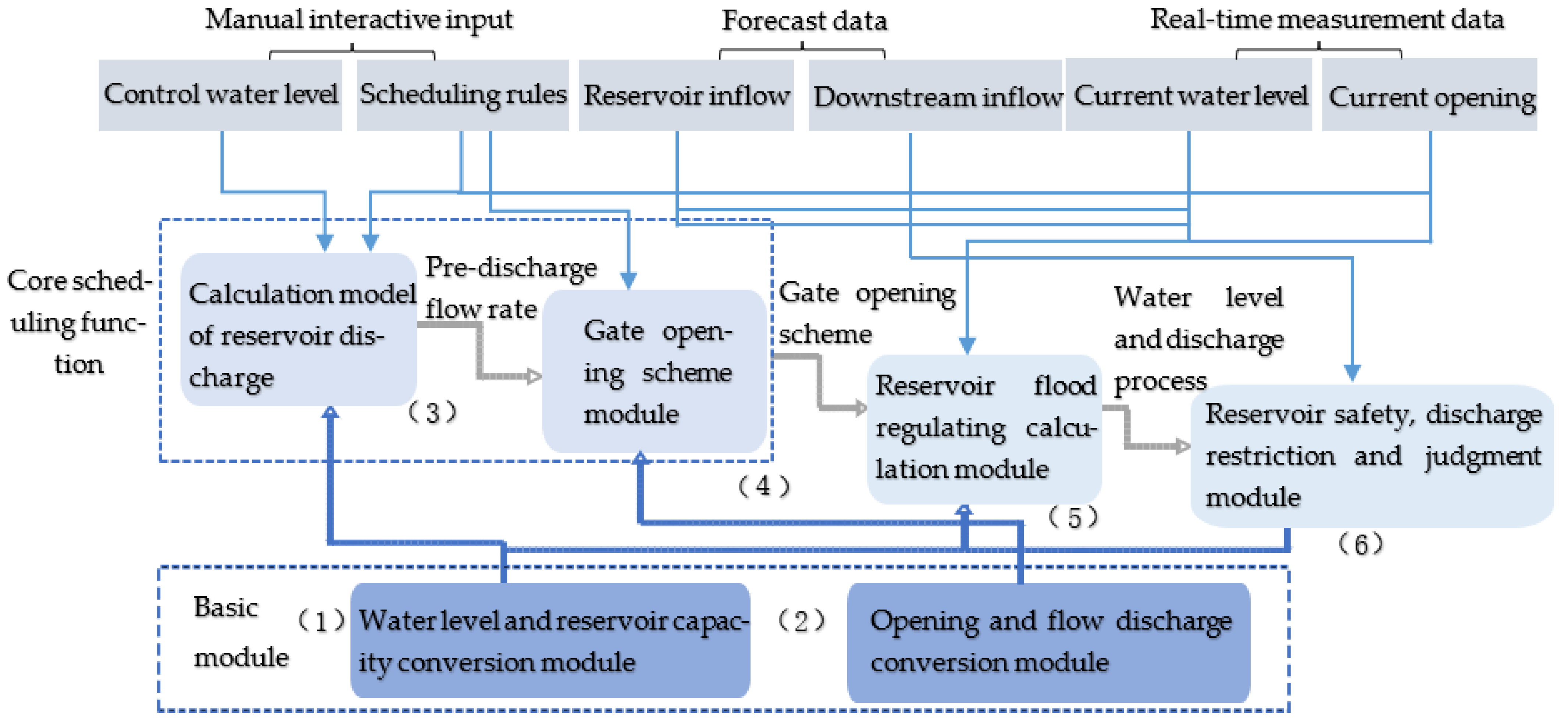

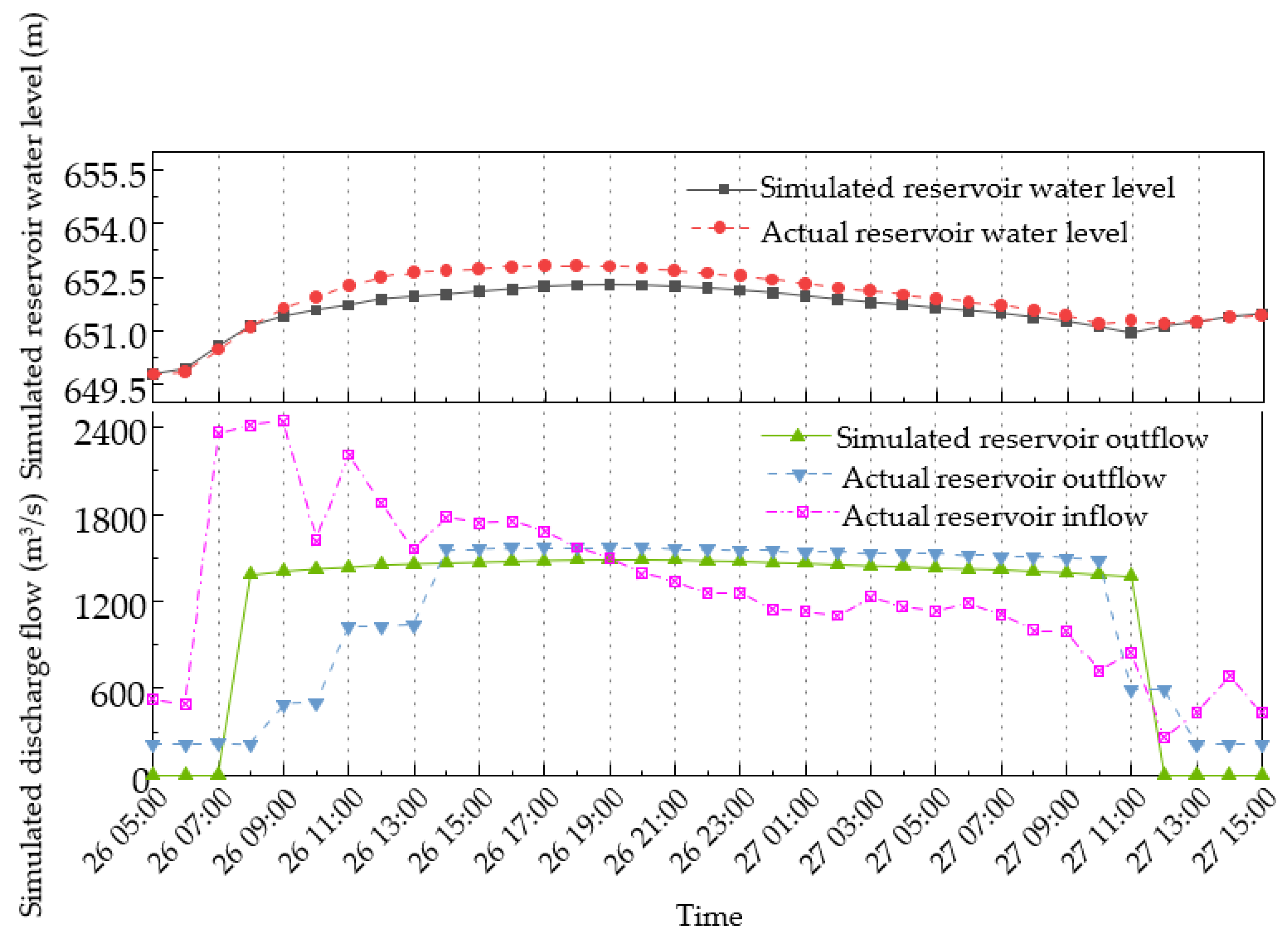

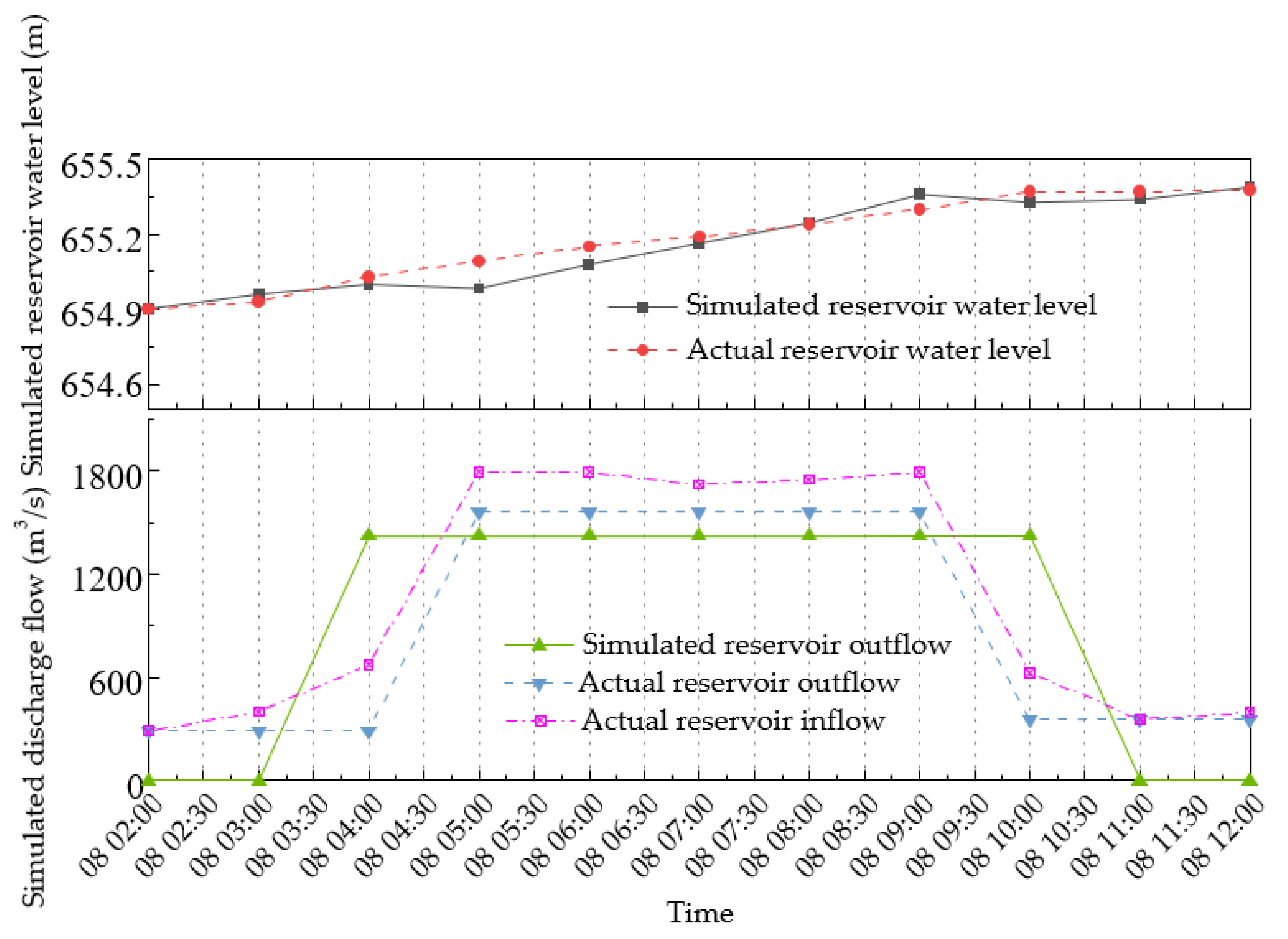
| Functions | Main Operating Objects * | Model Support |
|---|---|---|
| Flood prevention and early warning | / | Hydrological model |
| Flood control scheduling | Wudu Reservoir and water intake complex | Flood control scheduling model |
| Drought resistance and early warning | / | Water demand forecasting model |
| Water supply scheduling | Wudu Reservoir, water intake complex, channel system, and gate | Water supply scheduling model |
| Hydropower generation scheduling | Wudu Reservoir and Shilongzui Hydropower Station | Hydropower scheduling model |
| Water quality ecological scheduling | Wudu Reservoir, water intake complex, channel system, and gate | Water quality model |
| Module Name | Plug-In Name | Input | Output * | |
|---|---|---|---|---|
| Model Parameter | Variable * | |||
| Reservoir basic attribute module | Converting water level to reservoir capacity | Relationship between water level and reservoir capacity | Z | W |
| Converting reservoir capacity to water level | Relationship between water level and reservoir capacity | W | Z | |
| Calculation of reservoir outflow discharge | Sluice gate opening, floor elevation, and number of orifices | Z, e | q | |
| Calculation of reservoir gate opening | Sluice gate opening, floor elevation, and number of orifices | Z, q | e | |
| Reservoir basic scheduling module | Calculation of average pre-discharge flow rate | ε | Qls, Z, ZT, qdz | qxx |
| Gate operation scheme | Discharge dispatching rules | Z, qxx | e | |
| Flood regulating calculation | Relationship between reservoir water level and outflow discharge | Qls, Z, e | q(t), Z(t) | |
| Judgment of safety discharge constraint | Rules for determining safety discharge | q | Judgment results | |
| Module Name | Plug-In Name | Input | Output * | |
|---|---|---|---|---|
| Model Parameter | Variable * | |||
| Basic attribute module of intake complex | Discharge calculation of broad-crested weir | Size of weir, elevation of gate, and number of orifices | hu, hd, e | q |
| Gate opening calculation of broad-crested weir | Size of weir, elevation of gate, and number of orifices | hu, hd, q | e | |
| Basic water distribution scheduling module of intake complex | Water intake scheme for canal headwork sluice section | Size of weir, elevation of gate, and number of orifices | hu, hd, qtar | e_qs |
| Water intake scheme for Fujiang sluice section | Size of weir, elevation of gate, and number of orifices | hu, hd, qtar, qxxwd, e0 | e_fj | |
| Plug-In Name | Classes | Methods | Functions |
|---|---|---|---|
| Converting water level to reservoir capacity | ReservoirAttribute | level_to_volume() | Converting reservoir water level into corresponding reservoir capacity |
| Converting reservoir capacity to water level | ReservoirAttribute | volume_to_level() | Converting reservoir capacity into the corresponding water level |
| Calculation of reservoir outflow discharge | ReservoirAttribute | discharge_calculate() | Calculation of outflow discharge through reservoir water level and gate opening |
| Calculation of reservoir gate opening | ReservoirAttribute | gatage_calculate() | Calculation of gate opening by reservoir water level and outflow discharge |
| Calculation of average pre-discharge flow rate | ReservoirRegulation | average_ pre_ discharge() | Calculating average pre-discharge flow rate in future period with forecast data |
| Gate operation scheme | ReservoirRegulation | sluice_operation_scheme() | Opening and closing scheme sluice gate |
| Flood regulating calculation | ReservoirRegulation | flood_routing() | Flood calculation according to incoming water forecast and discharge plan |
| Judgment of safety discharge constraint | ReservoirRegulation | safety_discharge() | Determining whether outflow discharge conforms to safety discharge restriction |
| Plug-In Name | Classes | Methods | Functions |
|---|---|---|---|
| Discharge calculation of broad-crested weir | BarrageUniversal | broad_crested_weir_discharge() | Calculating the flow rate of the broad-crested weir with a specified gate opening |
| Gate opening calculation of broad-crested weir | BarrageUniversal | broad_crested_weir_gatage() | Calculating the gate opening of the broad-crested weir with a specified flow rate |
| Water intake scheme for canal headwork sluice section | BarrageRegulation | barrage_operation_scheme_qs() | Gate opening scheme of canal headwork sluice section |
| Water intake scheme for Fujiang sluice section | BarrageRegulation | barrage_operation_scheme_fj() | Gate opening scheme of Fujiang sluice section |
| Operating Condition | Period | Initial Water Level (m) | End Water Level of Specified Period (m) | Initial Gate Opening (m) | Other Water Consumption * (m3/s) | Flow Rate of Taibai Station (m3/s) | Flow Rate of Xiangshui Station after 2 h (m3/s) |
|---|---|---|---|---|---|---|---|
| A1 | 1 | 649.78 | 651.44 | e0so *= [0, 0] e0so * = [0, 0, 0] | 0 | 0 | 0 |
| B1 | 2 | 654.90 | 655.38 | e0so*= [0, 0] e0so *= [0, 0, 0] | 0 | 0 | 0 |
| Operating Condition | Time | Average Outflow Discharge (m3/s) |
|---|---|---|
| A1 | 26 September 2021 05:00:00~26 September 2021 07:00:00 | 0 |
| 26 September 2021 08:00:00~27 September 2021 11:00:00 | 1386 | |
| 27 September 2021 12:00:00~27 September 2021 15:00:00 | 0 | |
| B1 | 8 October 2021 02:00:00~8 October 2021 05:00:00 | 0 |
| 8 October 2021 06:00:00~8 October 2021 10:00:00 | 1432 | |
| 8 October 2021 11:00:00~8 October 2021 12:00:00 | 0 |
| Operating Condition | Average Pre-Discharge Flow Rate (m3/s) | Initial Water Level (m) | Bottom Orifice Rule * |
|---|---|---|---|
| A2 | 1386 | 651.13 | R0 |
| B2 | 1386 | 651.13 | R1 |
| C2 | 1432 | 654.95 | R0 |
| D2 | 1432 | 654.95 | R1 |
| Operating Condition | Simulated Gate Opening Scheme (m) | Average Outflow Discharge under Simulation Scenario (m3/s) |
|---|---|---|
| A2 | eso = [9.21, 9.21], ebo *= [0, 0, 0] | 1386 |
| B2 | eso = [9.21, 9.21], ebo *= [0, 0, 0] | 1386 |
| C2 | eso = [0, 0], ebo *= [2.6, 2.6, 2.6] | 1454 |
| D2 | eso = [0, 0], ebo *= [0.4, 7, 0.4] | 1418 |
| Operating Condition | Reservoir Inflow (m3/s) | Initial Water Level (m) | Gate Opening Scheme (m) | Restricted Water Level (m) | Safety Discharge (m3/s) | Other Water Consumption (m3/s) |
|---|---|---|---|---|---|---|
| A3 | Period 1 | 649.78 | eso = [9.21, 9.21], eso = [0, 0, 0] | 658 | Unrestricted | 0 |
| B3 | Period 2 | 654.90 | eso = [0, 0], eso = [2.6, 2.6, 2.6] | 658 | Unrestricted | 0 |
| C3 | Period 2 | 654.90 | eso = [0, 0], eso = [0.4, 7, 0.4] | 658 | Unrestricted | 0 |
Publisher’s Note: MDPI stays neutral with regard to jurisdictional claims in published maps and institutional affiliations. |
© 2022 by the authors. Licensee MDPI, Basel, Switzerland. This article is an open access article distributed under the terms and conditions of the Creative Commons Attribution (CC BY) license (https://creativecommons.org/licenses/by/4.0/).
Share and Cite
Jiang, B.; Pan, L.; Qin, G.; Su, X.; Cai, F.; Liang, Y. Development of an Integrated Water Resource Scheduling Model Based on Platform Plug-In: A Case Study of the Wudu Diversion and Irrigation Area, China. Water 2022, 14, 3671. https://doi.org/10.3390/w14223671
Jiang B, Pan L, Qin G, Su X, Cai F, Liang Y. Development of an Integrated Water Resource Scheduling Model Based on Platform Plug-In: A Case Study of the Wudu Diversion and Irrigation Area, China. Water. 2022; 14(22):3671. https://doi.org/10.3390/w14223671
Chicago/Turabian StyleJiang, Beihan, Long Pan, Genquan Qin, Xiaolin Su, Feng Cai, and Yue Liang. 2022. "Development of an Integrated Water Resource Scheduling Model Based on Platform Plug-In: A Case Study of the Wudu Diversion and Irrigation Area, China" Water 14, no. 22: 3671. https://doi.org/10.3390/w14223671
APA StyleJiang, B., Pan, L., Qin, G., Su, X., Cai, F., & Liang, Y. (2022). Development of an Integrated Water Resource Scheduling Model Based on Platform Plug-In: A Case Study of the Wudu Diversion and Irrigation Area, China. Water, 14(22), 3671. https://doi.org/10.3390/w14223671





